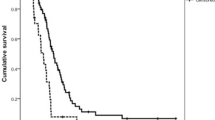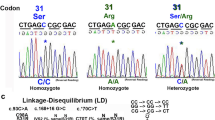Abstract
ERCC1 and ERCC2 have been known to belong to the nucleotide excision repair (NER) pathway and are essential to the repair of cisplatin DNA adducts. In the present study, we have examined the potential correlation of ERCC1, ERCC2 mRNA expression and single nucleotide polymorphism (SNP) to chemotherapy drug cytotoxicity from 49 human gliomas. Fresh human glioma specimens were obtained during surgery. SNPs of ERCC1 and ERCC2 was determined by single strand conformation polymorphism (SSCP) and sequencing. ERCC1 and ERCC2 expression was quantified using real-time quantitative reverse transcription-PCR. Chemotherapy drug cytotoxicity was determined by the tetrazolium (MTT) assay for cisplatin (CDDP), 1,3-bis-(2-chloroethyl)-1-nitrosourea (BCNU), vincristine (VCR) and teniposide (VM26). The results show that there was no statistically significant association between the C8092A polymorphism of ERCC1 or codon 312 and codon 751 polymorphisms of ERCC2 and the chemotherapy drug cytotoxicity. However there was a strong correlation between ERCC1 and ERCC2 mRNA expression levels (Spearman r = 0.42; P < 0.003). Further more, tumor samples with low ERCC1 mRNA expression levels showed enhanced CDDP cytotoxicity (P = 0.0001) while ERCC2 expression was reversely correlated with BCNU cytotoxicity (P = 0.004). In sum, Our results indicated that ERCC1 mRNA expression is associated with CDDP cytotoxicity and ERCC2 mRNA levels is related with BCNU cytotoxicity, while there was no correlation between SNP of ERCC1, ERCC2 and in vitro cytotoxicity of four anticancer drugs, CDDP, BCNU, VCR and VM26.
Similar content being viewed by others
Abbreviations
- BCNU:
-
1,3-bis-(2-chloroethyl)-1-nitrosourea
- CDDP:
-
Cisplatin
- DMSO:
-
Dimethylsulfoxide
- ERCC1:
-
Excision repair cross complementing protein 1
- ERCC2:
-
Excision repair cross complementing protein 2
- HDRA:
-
Histoculture drug response assay
- MTT:
-
Tetrazolium
- NSCLC:
-
Non-small cell lung cancer
- NER:
-
Nucleotide excision repair
- PPC:
-
Peak plasma concentration
- SNP:
-
Single nucleotide polymorphism
- SSCP:
-
Single strand conformation polymorphism
- SarCNU:
-
(2-chloroethyl)-3-sarcosinamide-1-nitrosourea
- VCR:
-
Vincristine
- VM26:
-
Teniposide
Reference
Furukawa T KT, Hoffman RM (1995) Clinical applications of the histoculture drug response assay. Clin Cancer Res 1(3):305–311
Hoffman R (1991) In vitro sensitivity assays in cancer: a review, analysis and prognosis. J Clin Lab Anal 5:133
Suda S AS, Sekiguchi H, Kasai Y, Ito K, Nakao A (2002) Evaluation of the histoculture drug response assay as a sensitivity test for anticancer agents. Surg Today 32(6):477–481
Furuta T, Ueda T, Aune G, Sarasin A, Kraemer KH, Pommier Y (2002) Transcription-coupled nucleotide excision repair as a determinant of cisplatin sensitivity of human cells. Cancer Res 62(17):4899–4902
Yu JJ, Lee KB, Mu C, Li Q, Abernathy TV, Bostick-Bruton F, Reed E (2000) Comparison of two human ovarian carcinoma cell lines (A2780/CP70 and MCAS) that are equally resistant to platinum, but differ at codon 118 of the ERCC1 gene. Int J Oncol 16(3):555–560
Metzger R, Leichman CG, Danenberg KD, Danenberg PV, Lenz HJ, Hayashi K, Groshen S, Salonga D, Cohen H, Laine L, et al (1998) ERCC1 mRNA levels complement thymidylate synthase mRNA levels in predicting response and survival for gastric cancer patients receiving combination cisplatin and fluorouracil chemotherapy. J Clin Oncol 16(1):309–316
Simon GR, Sharma S, Cantor A, Smith P, Bepler G (2005) ERCC1 expression is a predictor of survival in resected patients with non-small cell lung cancer. Chest 127(3):978–983
Rosell R, Lord RV, Taron M, Reguart N (2002) DNA repair and cisplatin resistance in non-small-cell lung cancer. Lung Cancer 38(3):217–227
Aloyz R, Xu ZY, Bello V, Bergeron J, Han FY, Yan Y, Malapetsa A, Alaoui-Jamali MA, Duncan AM, Panasci L (2002) Regulation of cisplatin resistance and homologous recombinational repair by the TFIIH subunit XPD. Cancer Res 62(19):5457–5462
Chen ZP, Malapetsa A, Marcantonio D, Mohr G, Brien S, Panasci LC (1996) Correlation of chloroethylnitrosourea resistance with ERCC-2 expression in human tumor cell lines as determined by quantitative competitive polymerase chain reaction. Cancer Res 56(11):2475–2478
Weaver DA, Crawford EL, Warner KA, Elkhairi F, Khuder SA, Willey JC (2005) ABCC5, ERCC2, XPA and XRCC1 transcript abundance levels correlate with cisplatin chemoresistance in non-small cell lung cancer cell lines. Mol Cancer 4(1):18
Dabholkar M, Bostick-Bruton F, Weber C, Egwuagu C, Bohr VA, Reed E (1993) Expression of excision repair genes in non-malignant bone marrow from cancer patients. Mutat Res 293(2):151–160
Sheibani N, Eastman A (1990) Analysis of various mRNA potentially involved in cisplatin resistance of murine leukemia L1210 cells. Cancer Lett 52(3):179–185
Vogel U, Dybdahl M, Frentz G, Nexo BA (2000) DNA repair capacity: inconsistency between effect of over-expression of five NER genes and the correlation to mRNA levels in primary lymphocytes. Mutat Res 461(3):197–210
Hu G MB, Stensland HMFR, et al (2002) Efficient discovery of single-nuceotide polymorphisms in coding regions of human gene. Pharmacogenomics J 2:236–242
Shen MR, Jones IM, Mohrenweiser H (1998) Nonconservative amino acid substitution variants exist at polymorphic frequency in DNA repair genes in healthy humans. Cancer Res 58(4):604–608
Caggana M, Kilgallen J, Conroy JM, Wiencke JK, Kelsey KT, Miike R, Chen P, Wrensch MR (2001) Associations between ERCC2 polymorphisms and gliomas. Cancer Epidemiol Biomarkers Prev 10(4):355–360
Chen P, Wiencke J, Aldape K, Kesler-Diaz A, Miike R, Kelsey K, Lee M, Liu J, Wrensch M (2000) Association of an ERCC1 polymorphism with adult-onset glioma. Cancer Epidemiol Biomarkers Prev 9(8):843–847
Yu JJ, Mu C, Lee KB, Okamoto A, Reed EL, Bostick-Bruton F, Mitchell KC, Reed E (1997) A nucleotide polymorphism in ERCC1 in human ovarian cancer cell lines and tumor tissues. Mutat Res 382(1–2):13–20
Zhou W, Gurubhagavatula S, Liu G, Park S, Neuberg DS, Wain JC, Lynch TJ, Su L, Christiani DC (2004) Excision repair cross-complementation group 1 polymorphism predicts overall survival in advanced non-smallcell lung cancer patients treated with platinum-based chemotherapy. Clin Cancer Res 10(15):4939–4943
Rosell R, Taron M, Camps C, Lopez-Vivanco G (2003) Influence of genetic markers on survival in non-small cell lung cancer. Drugs Today (Barc) 39(10):775–786
Stoehlmacher J, Park DJ, Zhang W, Yang D, Groshen S, Zahedy S, Lenz HJ (2004) A multivariate analysis of genomic polymorphisms: prediction of clinical outcome to 5-FU/oxaliplatin combination chemotherapy in refractory colorectal cancer. Br J Cancer 91(2):344–354
Zhang JY, Chen ZP (2003) In vitro chemotherapy drug sensitivity test in human malignant brain tumor. Guangdong Medicine 24(7):715–717
Sloan AE, Dansey R, Zamorano L, Barger G, Hamm C, Diaz F, Baynes R, Wood G (2000) Adoptive immunotherapy in patients with recurrent malignant glioma: preliminary results of using autologous whole-tumor vaccine plus granulocyte-macrophage colony-stimulating factor and adoptive transfer of anti-CD3-activated lymphocytes. Neurosurg Focus 9(6):e9
Altaha R, Liang X, Yu JJ, Reed E (2004) Excision repair cross complementing-group 1: gene expression and platinum resistance. Int J Mol Med 14(6):959–970
Park DJ, Stoehlmacher J, Zhang W, Tsao-Wei DD, Groshen S, Lenz HJ (2001) A Xeroderma pigmentosum group D gene polymorphism predicts clinical outcome to platinum-based chemotherapy in patients with advanced colorectal cancer. Cancer Res 61(24):8654–8658
Mort R, Mo L, McEwan C, Melton DW (2003) Lack of involvement of nucleotide excision repair gene polymorphisms in colorectal cancer. Br J Cancer 89(2):333–337
Duell EJ, Wiencke JK, Cheng TJ, Varkonyi A, Zuo ZF, Ashok TD, Mark EJ, Wain JC, Christiani DC, Kelsey KT (2000) Polymorphisms in the DNA repair genes XRCC1 and ERCC2 and biomarkers of DNA damage in human blood mononuclear cells. Carcinogenesis 21(5):965–971
Cheng L, Guan Y, Li L, Legerski RJ, Einspahr J, Bangert J, Alberts DS, Wei Q (1999) Expression in normal human tissues of five nucleotide excision repair genes measured simultaneously by multiplex reverse transcription-polymerase chain reaction. Cancer Epidemiol Biomarkers Prev 8(9):801–807
Chen ZP, McQuillan A, Mohr G, Panasci LC (1998) Excision repair cross-complementing rodent repair deficiency gene 2 expression and chloroethylnitrosourea resistance in human glioma cell lines. Neurosurgery 42(5):1112–1119
Chen ZP, Malapetsa A, McQuillan A, Marcantonio D, Bello V, Mohr G, Remack J, Brent TP, Panasci LC (1997) Evidence for nucleotide excision repair as a modifying factor of O6-methylguanine-DNA methyltransferase-mediated innate chloroethylnitrosourea resistance in human tumor cell lines. Mol Pharmacol 52(5):815–820
Author information
Authors and Affiliations
Corresponding author
Additional information
This work was supported by National Nature Science Foundation of China No. 30271329
Rights and permissions
About this article
Cite this article
Chen, H., Shao, C., Shi, H. et al. Single nucleotide polymorphisms and expression of ERCC1 and ERCC2 vis-à-vis chemotherapy drug cytotoxicity in human glioma. J Neurooncol 82, 257–262 (2007). https://doi.org/10.1007/s11060-006-9290-2
Received:
Accepted:
Published:
Issue Date:
DOI: https://doi.org/10.1007/s11060-006-9290-2




